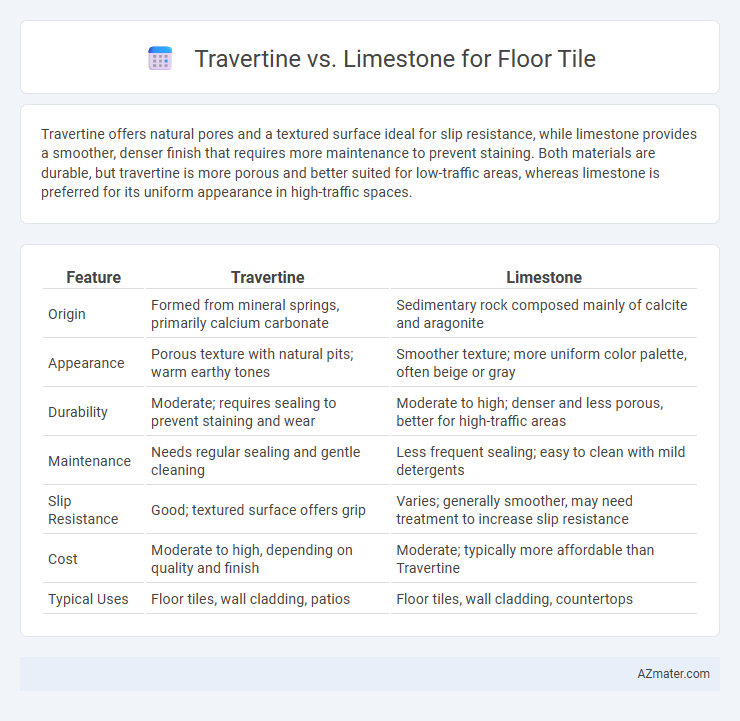Travertine offers natural pores and a textured surface ideal for slip resistance, while limestone provides a smoother, denser finish that requires more maintenance to prevent staining. Both materials are durable, but travertine is more porous and better suited for low-traffic areas, whereas limestone is preferred for its uniform appearance in high-traffic spaces.
Table of Comparison
| Feature | Travertine | Limestone |
|---|---|---|
| Origin | Formed from mineral springs, primarily calcium carbonate | Sedimentary rock composed mainly of calcite and aragonite |
| Appearance | Porous texture with natural pits; warm earthy tones | Smoother texture; more uniform color palette, often beige or gray |
| Durability | Moderate; requires sealing to prevent staining and wear | Moderate to high; denser and less porous, better for high-traffic areas |
| Maintenance | Needs regular sealing and gentle cleaning | Less frequent sealing; easy to clean with mild detergents |
| Slip Resistance | Good; textured surface offers grip | Varies; generally smoother, may need treatment to increase slip resistance |
| Cost | Moderate to high, depending on quality and finish | Moderate; typically more affordable than Travertine |
| Typical Uses | Floor tiles, wall cladding, patios | Floor tiles, wall cladding, countertops |
Introduction to Travertine and Limestone as Floor Tiles
Travertine and limestone are popular natural stone choices for floor tiles, prized for their durability and unique textures. Travertine features a porous, fibrous appearance formed from calcium carbonate deposits in hot springs, offering a rustic yet elegant aesthetic. Limestone, composed primarily of skeletal fragments of marine organisms, provides a smoother, more uniform surface with subtle color variations ideal for versatile interior designs.
Composition and Formation Differences
Travertine is a form of limestone created through the rapid precipitation of calcium carbonate at mineral springs, resulting in a porous, fibrous texture with visible voids and a more varied surface. Limestone forms from the accumulation of marine organisms' skeletal fragments primarily composed of calcite, producing a denser and more uniform stone. These compositional and formation differences influence their durability, porosity, and suitability for floor tile applications.
Aesthetic Appeal: Colors and Textures
Travertine floor tiles showcase a natural, porous texture with distinctive holes and troughs that create a rustic and timeless aesthetic, available in warm earth tones like beige, cinnamon, and walnut. Limestone tiles offer a smoother, more uniform surface with subtle veining, presenting elegant hues ranging from soft grays to creamy whites, ideal for contemporary and classic interiors. Both materials provide unique visual appeal, but travertine emphasizes natural ruggedness while limestone delivers refined sophistication in colors and textures.
Durability and Hardness Comparison
Travertine and limestone, both popular natural stone options for floor tiles, differ significantly in durability and hardness. Travertine ranks higher on the Mohs hardness scale, typically between 6 and 7, making it more resistant to scratches and wear compared to limestone, which ranges from 3 to 4. This increased hardness allows travertine tiles to withstand heavy foot traffic and maintain their appearance longer, while limestone requires more careful maintenance to prevent damage and erosion over time.
Porosity and Water Resistance Factors
Travertine floor tiles exhibit moderate porosity, requiring proper sealing to enhance water resistance and prevent staining, making them suitable for low to moderate moisture areas. Limestone, characterized by higher porosity, absorbs water more readily, necessitating frequent sealing and maintenance to maintain durability in floor applications. Both materials offer natural aesthetics, but travertine's tighter pore structure generally provides better performance in moisture-prone environments compared to limestone.
Installation Process and Considerations
Travertine and limestone floor tiles require precise installation techniques due to their natural porosity and texture variations. Travertine often demands filling of its pits before sealing to prevent moisture absorption, while limestone's softer composition necessitates careful handling to avoid chipping during cutting and laying. Both materials benefit from a level subfloor and the use of a high-quality thin-set mortar specifically formulated for natural stone to ensure long-lasting adhesion and durability.
Maintenance and Cleaning Requirements
Travertine floor tiles require sealing every 1-2 years to prevent staining and damage due to their porous surface, whereas limestone tiles also need regular sealing but may be slightly more susceptible to acidic spills causing etching. Both materials demand gentle, pH-neutral cleaners to avoid surface corrosion and dullness. Routine sweeping and damp mopping with mild soap ensure longevity and maintain the natural beauty of these natural stone tiles.
Cost Comparison: Travertine vs Limestone
Travertine floor tiles generally cost between $4 to $7 per square foot, while limestone tiles range from $3 to $10 per square foot, influenced by quality and sourcing. Installation expenses for both materials are similar, averaging around $5 to $10 per square foot, depending on labor rates and tile complexity. Budget considerations often favor travertine for its consistent mid-range pricing, whereas limestone offers a wider price spectrum suitable for varying budgets.
Best Applications: Where Each Excels
Travertine floor tile excels in high-traffic areas like foyers and kitchens due to its durability and natural resistance to wear, while limestone is best suited for low-moisture environments such as bedrooms and living rooms because of its softer, more porous nature. Travertine's textured surface provides slip resistance, making it ideal for bathrooms and outdoor patios, whereas limestone offers a smooth, elegant finish perfect for formal spaces with light foot traffic. Both stone types complement different architectural styles, with travertine fitting rustic or Mediterranean designs and limestone enhancing classic or contemporary interiors.
Pros and Cons Summary for Homeowners
Travertine floor tiles offer natural durability, unique texture, and a warm aesthetic ideal for high-traffic areas but require regular sealing to prevent staining and erosion. Limestone provides a soft, elegant look with muted tones enhancing various decor styles, yet it is more porous and susceptible to scratches and moisture damage without proper maintenance. Homeowners prioritizing long-lasting flooring with natural beauty often prefer travertine, while those seeking a softer, classic appearance might choose limestone, balancing care needs with design preferences.

Infographic: Travertine vs Limestone for Floor Tile
 azmater.com
azmater.com